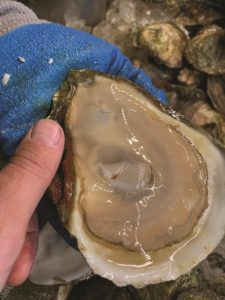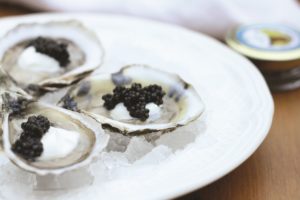I won’t blame you if you have your doubts when I tell you that your Thanksgiving dinner might be more authentic if you served fish instead of turkey.
There’s not actually a whole lot known about the harvest feast the Pilgrims had in Plymouth in 1621 with the Indians. Edward Winslow wrote about the hunting of waterfowl and how King Massasoit and his 90 Wampanoag men brought five venison to the three-day gathering. William Bradford mentioned it had been a good season for wild turkey and for corn that they used to make a type of corn meal porridge.

I always guessed that seafood didn’t play a big role on this holiday menu because the Puritans were farmers, not fishermen or foragers — or even good hunters, for that matter. No wonder only about half of them made it through the first winter here, right?
But there are good accounts of the fish the Europeans found when they arrived on these shores — cod, wild Atlantic salmon, clams, and way too much lobster. They used it as bait for eels.
Skip to the present, when most of our foraging and hunting happens at stores, yet there is still a lot to be thankful for here. The other day, I stumbled on a stellar patch of nettles. And right now, fishermen and shellfishermen are bringing in the best of the local bounty from our waters. The littlenecks and mussels are plump, the bay scallops are in, flatfish is pristine, and the monkfish is beautiful.
And then there are the oysters. They are fattening themselves up for the long, cold winter. The meat is full-bodied, briny, and creamy. Eating them at this time of year makes me grateful to live where I live.
I’m thankful, too, for the chance to enjoy them in ways the Pilgrims could not have imagined. I like them best raw — sometimes with mignonette or a drop of lemon or cocktail sauce. But here’s what I do for those Thanksgiving guests who want them cooked.
Turn the oven on to 400 degrees F, get out the butter, and mince a bit of garlic. As you shuck, place the oysters on a baking sheet, top with a pat of butter and some garlic, and put them in the oven for 8 minutes. If you’re not the kind to get distracted, you can also use the broiler for this — but keep an eye on them, as it takes only a couple of minutes. Either way, let them go just until the garlic turns golden. Finish them with a little parsley chopped fine and a squeeze of lemon.

You can also do these on the grill. Just be careful you don’t burn the oyster from the bottom and look out for flying hot shell fragments.
There are lots of ways to get creative, and none of them requires a recipe. Chop olives, onions, and red pepper really fine and mound some on each oyster with a little feta cheese. Or top each oyster with some smoky chorizo, chopped fine, and add a few drops of nuoc mam (Vietnamese fish sauce) before you give them a quick broil. Or do some chopped spinach with a mix of cream cheese, toasted fennel seed, and Pernod. Top that off with some Parmesan cheese, cook till the cheese bubbles, and you have something like the classic oysters Rockefeller. You’d be surprised how good oysters with guacamole and bacon are.
If you’re not one to light the oven or the grill, I have one more variation the Pilgrims never knew. Top a cold oyster with a dollop of crème fraiche or sour cream and a spoonful of caviar. You might even hit the whole thing with a splash of chilled vodka.



